Yaoming Cai
SLCGC: A lightweight Self-supervised Low-pass Contrastive Graph Clustering Network for Hyperspectral Images
Feb 05, 2025Abstract:Self-supervised hyperspectral image (HSI) clustering remains a fundamental yet challenging task due to the absence of labeled data and the inherent complexity of spatial-spectral interactions. While recent advancements have explored innovative approaches, existing methods face critical limitations in clustering accuracy, feature discriminability, computational efficiency, and robustness to noise, hindering their practical deployment. In this paper, a self-supervised efficient low-pass contrastive graph clustering (SLCGC) is introduced for HSIs. Our approach begins with homogeneous region generation, which aggregates pixels into spectrally consistent regions to preserve local spatial-spectral coherence while drastically reducing graph complexity. We then construct a structural graph using an adjacency matrix A and introduce a low-pass graph denoising mechanism to suppress high-frequency noise in the graph topology, ensuring stable feature propagation. A dual-branch graph contrastive learning module is developed, where Gaussian noise perturbations generate augmented views through two multilayer perceptrons (MLPs), and a cross-view contrastive loss enforces structural consistency between views to learn noise-invariant representations. Finally, latent embeddings optimized by this process are clustered via K-means. Extensive experiments and repeated comparative analysis have verified that our SLCGC contains high clustering accuracy, low computational complexity, and strong robustness. The code source will be available at https://github.com/DY-HYX.
GraphMamba: An Efficient Graph Structure Learning Vision Mamba for Hyperspectral Image Classification
Jul 11, 2024



Abstract:Efficient extraction of spectral sequences and geospatial information has always been a hot topic in hyperspectral image classification. In terms of spectral sequence feature capture, RNN and Transformer have become mainstream classification frameworks due to their long-range feature capture capabilities. In terms of spatial information aggregation, CNN enhances the receptive field to retain integrated spatial information as much as possible. However, the spectral feature-capturing architectures exhibit low computational efficiency, and CNNs lack the flexibility to perceive spatial contextual information. To address these issues, this paper proposes GraphMamba--an efficient graph structure learning vision Mamba classification framework that fully considers HSI characteristics to achieve deep spatial-spectral information mining. Specifically, we propose a novel hyperspectral visual GraphMamba processing paradigm (HVGM) that preserves spatial-spectral features by constructing spatial-spectral cubes and utilizes linear spectral encoding to enhance the operability of subsequent tasks. The core components of GraphMamba include the HyperMamba module for improving computational efficiency and the SpectralGCN module for adaptive spatial context awareness. The HyperMamba mitigates clutter interference by employing the global mask (GM) and introduces a parallel training inference architecture to alleviate computational bottlenecks. The SpatialGCN incorporates weighted multi-hop aggregation (WMA) spatial encoding to focus on highly correlated spatial structural features, thus flexibly aggregating contextual information while mitigating spatial noise interference. Extensive experiments were conducted on three different scales of real HSI datasets, and compared with the state-of-the-art classification frameworks, GraphMamba achieved optimal performance.
Large-Scale Hyperspectral Image Clustering Using Contrastive Learning
Nov 15, 2021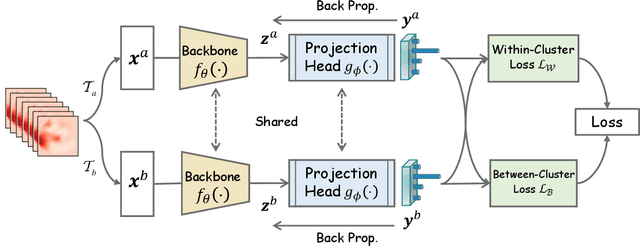

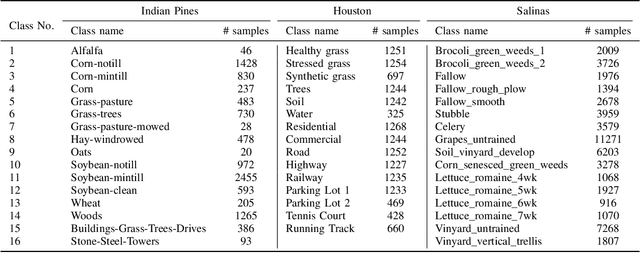
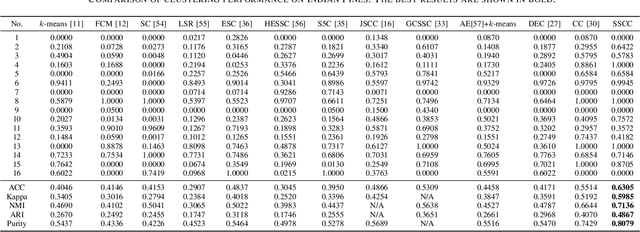
Abstract:Clustering of hyperspectral images is a fundamental but challenging task. The recent development of hyperspectral image clustering has evolved from shallow models to deep and achieved promising results in many benchmark datasets. However, their poor scalability, robustness, and generalization ability, mainly resulting from their offline clustering scenarios, greatly limit their application to large-scale hyperspectral data. To circumvent these problems, we present a scalable deep online clustering model, named Spectral-Spatial Contrastive Clustering (SSCC), based on self-supervised learning. Specifically, we exploit a symmetric twin neural network comprised of a projection head with a dimensionality of the cluster number to conduct dual contrastive learning from a spectral-spatial augmentation pool. We define the objective function by implicitly encouraging within-cluster similarity and reducing between-cluster redundancy. The resulting approach is trained in an end-to-end fashion by batch-wise optimization, making it robust in large-scale data and resulting in good generalization ability for unseen data. Extensive experiments on three hyperspectral image benchmarks demonstrate the effectiveness of our approach and show that we advance the state-of-the-art approaches by large margins.
Fully Linear Graph Convolutional Networks for Semi-Supervised Learning and Clustering
Nov 15, 2021



Abstract:This paper presents FLGC, a simple yet effective fully linear graph convolutional network for semi-supervised and unsupervised learning. Instead of using gradient descent, we train FLGC based on computing a global optimal closed-form solution with a decoupled procedure, resulting in a generalized linear framework and making it easier to implement, train, and apply. We show that (1) FLGC is powerful to deal with both graph-structured data and regular data, (2) training graph convolutional models with closed-form solutions improve computational efficiency without degrading performance, and (3) FLGC acts as a natural generalization of classic linear models in the non-Euclidean domain, e.g., ridge regression and subspace clustering. Furthermore, we implement a semi-supervised FLGC and an unsupervised FLGC by introducing an initial residual strategy, enabling FLGC to aggregate long-range neighborhoods and alleviate over-smoothing. We compare our semi-supervised and unsupervised FLGCs against many state-of-the-art methods on a variety of classification and clustering benchmarks, demonstrating that the proposed FLGC models consistently outperform previous methods in terms of accuracy, robustness, and learning efficiency. The core code of our FLGC is released at https://github.com/AngryCai/FLGC.
Graph Convolutional Subspace Clustering: A Robust Subspace Clustering Framework for Hyperspectral Image
Apr 22, 2020

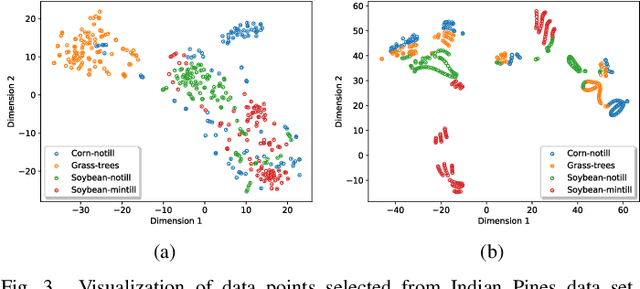

Abstract:Hyperspectral image (HSI) clustering is a challenging task due to the high complexity of HSI data. Subspace clustering has been proven to be powerful for exploiting the intrinsic relationship between data points. Despite the impressive performance in the HSI clustering, traditional subspace clustering methods often ignore the inherent structural information among data. In this paper, we revisit the subspace clustering with graph convolution and present a novel subspace clustering framework called Graph Convolutional Subspace Clustering (GCSC) for robust HSI clustering. Specifically, the framework recasts the self-expressiveness property of the data into the non-Euclidean domain, which results in a more robust graph embedding dictionary. We show that traditional subspace clustering models are the special forms of our framework with the Euclidean data. Basing on the framework, we further propose two novel subspace clustering models by using the Frobenius norm, namely Efficient GCSC (EGCSC) and Efficient Kernel GCSC (EKGCSC). Both models have a globally optimal closed-form solution, which makes them easier to implement, train, and apply in practice. Extensive experiments on three popular HSI datasets demonstrate that EGCSC and EKGCSC can achieve state-of-the-art clustering performance and dramatically outperforms many existing methods with significant margins.
BS-Nets: An End-to-End Framework For Band Selection of Hyperspectral Image
Apr 17, 2019
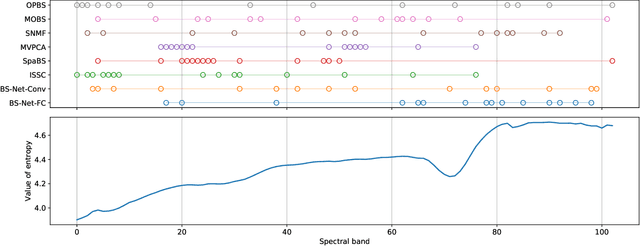
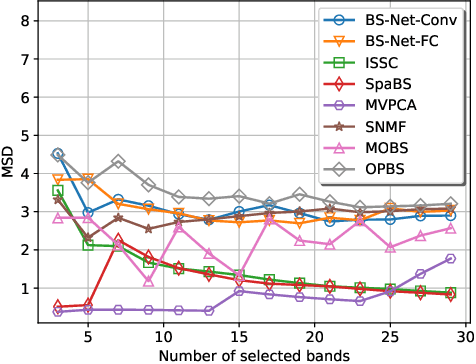
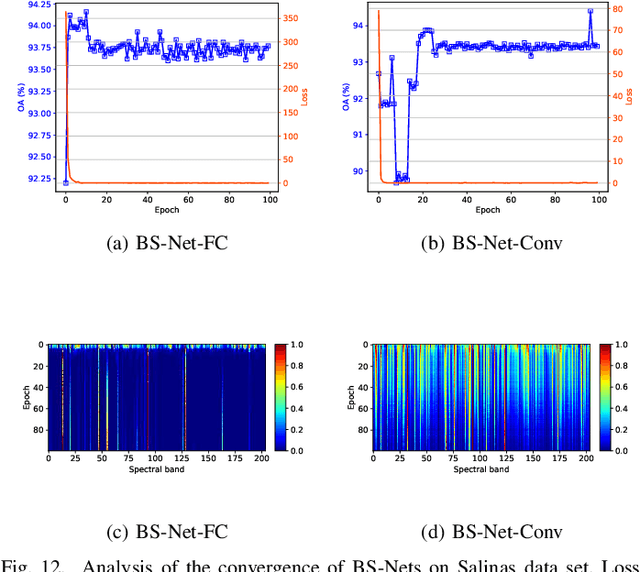
Abstract:Hyperspectral image (HSI) consists of hundreds of continuous narrow bands with high spectral correlation, which would lead to the so-called Hughes phenomenon and the high computational cost in processing. Band selection has been proven effective in avoiding such problems by removing the redundant bands. However, many of existing band selection methods separately estimate the significance for every single band and cannot fully consider the nonlinear and global interaction between spectral bands. In this paper, by assuming that a complete HSI can be reconstructed from its few informative bands, we propose a general band selection framework, Band Selection Network (termed as BS-Net). The framework consists of a band attention module (BAM), which aims to explicitly model the nonlinear inter-dependencies between spectral bands, and a reconstruction network (RecNet), which is used to restore the original HSI cube from the learned informative bands, resulting in a flexible architecture. The resulting framework is end-to-end trainable, making it easier to train from scratch and to combine with existing networks. We implement two BS-Nets respectively using fully connected networks (BS-Net-FC) and convolutional neural networks (BS-Net-Conv), and compare the results with many existing band selection approaches for three real hyperspectral images, demonstrating that the proposed BS-Nets can accurately select informative band subset with less redundancy and achieve significantly better classification performance with an acceptable time cost.
 Add to Chrome
Add to Chrome Add to Firefox
Add to Firefox Add to Edge
Add to Edge